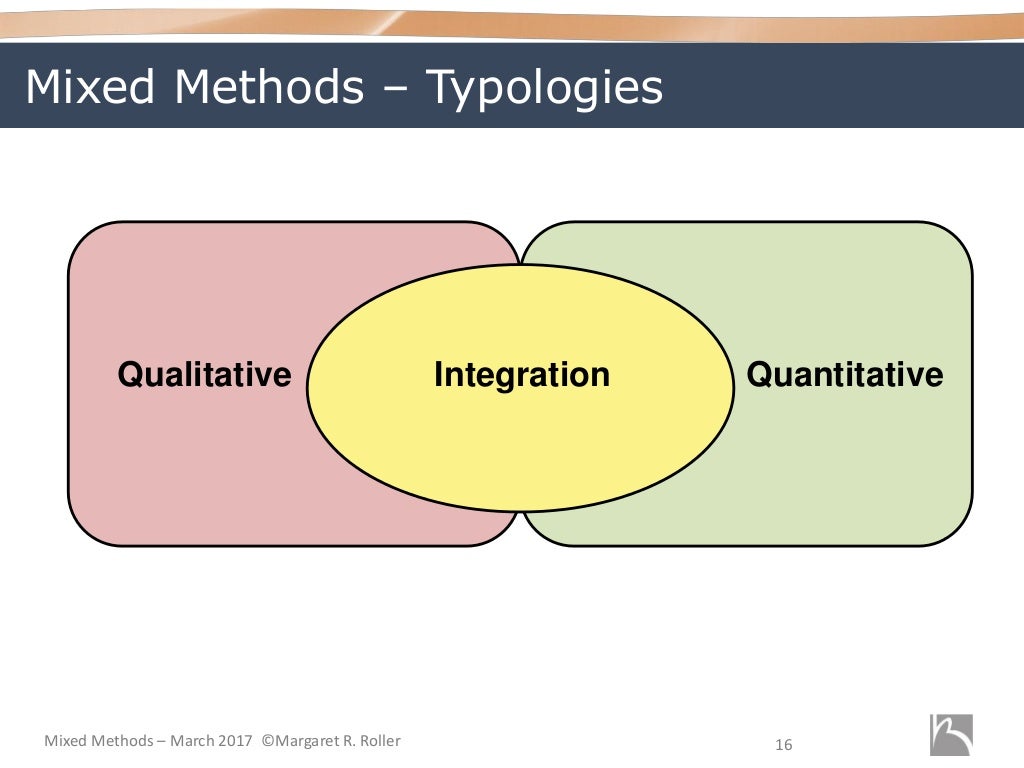Table Of Content

It is also possible to conduct the interviews after the survey data have been collected (or vice versa); in that case, research activities are performed sequentially. Similarly, a study with the purpose of expansion can be designed in which data on an effect and the intervention process are collected simultaneously, or they can be collected sequentially. This framework mixes qualitative and quantitative data collection methods in stages to gather a more nuanced view of the research question. An example of this is a study that first has an online survey to collect initial data and is followed by in-depth interviews to gain further insights. By integrating data from both quantitative and qualitative sources, researchers can gain valuable insights into their research topic.

Point of integration
By following this integrated and uniform guideline, personal biases can be avoided, leading to improved performance and ensuring that patients are not overlooked. Additionally, the use of an integrated obstetric telephone triage guideline promotes independent decision-making and reduces errors in triage decision-making. One of the major limitations of the present study was the lack of access to obstetric telephone triage guidelines of different countries with various healthcare systems in the world.
The design of an Obstetric Telephone Triage Guideline (OTTG): a mixed method study
The COVID-19 pandemic prompted a series of quick-turnaround policy changes across federal nutrition assistance programs, including WIC. This is one of the first studies to our knowledge that sought to understand if the policy changes to the WIC CVB for fruits and vegetables were implemented as intended at the WIC State and local agency level. Policy makers have a unique opportunity to help increase access to healthy food for millions of families nationwide. Despite some implementation challenges, the increased CVB, especially at $35/month, shows promise in improving WIC participants’ fruit and vegetable access and overall satisfaction with WIC.
The Growing Importance of Mixed-Methods Research in Health
For each type of research, an example was created to illustrate how each study design might be applied to address similar but different nursing research aims within the same general nursing research area. MMR challenges the mono-method approaches that are still dominant in the social sciences, and this is both refreshing and important. There are differences in opinion as to how this is best achieved, but there is widespread agreement that some kind of common methodological and conceptual foundation of MMR is needed. To this end, some propose a broad methodology that can serve as distinct marker of MMR research. When they (later on in the text) provide two methodological principles that differentiate MMR from other communities of scholars, they state that they regard it as a “crucial mission” for the MMR community to generate distinct methodological principles (Tashakkori and Teddlie 2010b, pp. 16–17).
Applying mixed methods research designs to key challenges and complexities in business - Nature.com
Applying mixed methods research designs to key challenges and complexities in business.
Posted: Wed, 29 Nov 2023 18:02:47 GMT [source]
Community Engagement Program
We agree with Greene (2007), who states that the value of the typological approach mainly lies in the different dimensions of mixed methods that result from its classifications. In this article, the primary dimensions include purpose, theoretical drive, timing, point of integration, typological vs. interactive approaches, planned vs. emergent designs, and complexity (also see secondary dimensions in Table 1). Unfortunately, all of these dimensions are not reflected in any single design typology reviewed here.

Access this chapter
The embedded design is when the quantitative and qualitative data are collected simultaneously, but the qualitative data is embedded within the quantitative data. This design is best used when you want to focus on the quantitative data but still need to understand how the qualitative data further explains it. Mixed methods research is a great choice when quantitative or qualitative data alone will not sufficiently answer a research question.
Dimension of complexity
In practice, however, one single study often serves more than one purpose (Schoonenboom et al. 2017). The more purposes that are included in one study, the more difficult it becomes to select a design on the basis of the purpose of the investigation, as advised by Greene (2007). For more information on how to articulate design complexity based on multiple purposes of mixing, see Schoonenboom et al. (2017). The exploratory sequential design collects qualitative data first, followed by quantitative data. This type of mixed methods research is used when the goal is to explore a topic before collecting any quantitative data.
Mixed methods evaluation of the COVID-19 changes to the WIC cash-value benefit for fruits and vegetables
In short, we need more training on mixed-methods research for a range of health researchers and health professionals. There are several challenges in identifying expertise of both methods and in working with a multidisciplinary, interdisciplinary, or transdisciplinary team [20]. It increases costs and resources, takes longer to complete as mixed-methods design often involves multiple stages of data collection and separate data analysis [4,5]. Moreover, conducting mixed-methods research does not necessarily guarantee an improvement in the quality of health research. Therefore, mixed-methods research is only appropriate when there are appropriate research questions [4,6].
2 Data collection
We agree with Greene (2015) that mixed methods research can be integrated at the levels of method, methodology, and paradigm. Therefore, equal-status mixed methods research (that we often advocate) is also called “interactive mixed methods research”. The number of possible purposes for mixing is very large and is increasing; hence, it is not possible to provide an exhaustive list.
The interviews lasted approximately 30 min, and respondents were given the option to accept a $30 gift card or donate $30 to a charity. To help increase the diversity of responses, we tracked responses by FNS Region, race, ethnicity, and rural/urban, and tailored our recruitment strategies to ensure responses across the different characteristics similar to the State and local agency interviews. The purpose of this article is to help researchers to understand how to design a mixed methods research study. Perhaps the simplest approach is to design is to look at a single book and select one from the few designs included in that book. Here we have shown that one often needs to construct a research design to fit one’s unique research situation and questions.
This may reflect the general lack of stability in the lives of PEH or limitations in the appeal of such a program to some portion of the unhoused population. Future analysis will compare those who engaged in the intervention versus those who did not to provide some insight into potential differences. It is also unclear how increased transparency about the prospect of basic income would have changed engagement and retention in the program or study. Another factor that may have contributed to attrition is a delay in the matching process that sometimes occurred when not enough volunteers were available to meet the demand, which could have discouraged unhoused people who signed up for the program from participating. Future analyses will attempt to understand who ended up volunteering for this program and why they volunteered, as well as how long it takes to match participants and under what circumstances a match is successful.
This human subjects’ research is being performed in accordance with the Declaration of Helsinki with protocols approved by the first author’s institutional review board. Reporting of study protocols follows the SPIRIT guidelines [47], which include a schedule of enrollment, interventions, and assessments, as depicted in Fig. We received redemption data from 27 State agencies and interviewed 23 State agencies, 61 local agencies, and 76 caregivers of child WIC participants. CVB monthly redemptions increased at $35/child/month compared to $9/child/month; however, adjusted ITS analyses found a decrease in redemption rates at $35/child/month. The decrease was not significant when the transition/first implementation month was excluded with rates progressively increasing over time.











